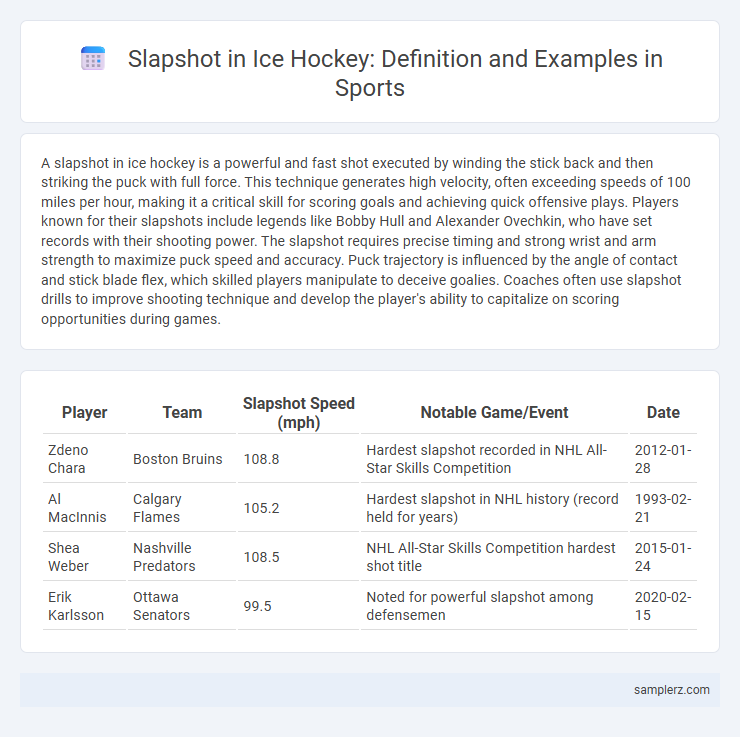A slapshot in ice hockey is a powerful and fast shot executed by winding the stick back and then striking the puck with full force. This technique generates high velocity, often exceeding speeds of 100 miles per hour, making it a critical skill for scoring goals and achieving quick offensive plays. Players known for their slapshots include legends like Bobby Hull and Alexander Ovechkin, who have set records with their shooting power. The slapshot requires precise timing and strong wrist and arm strength to maximize puck speed and accuracy. Puck trajectory is influenced by the angle of contact and stick blade flex, which skilled players manipulate to deceive goalies. Coaches often use slapshot drills to improve shooting technique and develop the player's ability to capitalize on scoring opportunities during games.
Table of Comparison
| Player | Team | Slapshot Speed (mph) | Notable Game/Event | Date |
|---|---|---|---|---|
| Zdeno Chara | Boston Bruins | 108.8 | Hardest slapshot recorded in NHL All-Star Skills Competition | 2012-01-28 |
| Al MacInnis | Calgary Flames | 105.2 | Hardest slapshot in NHL history (record held for years) | 1993-02-21 |
| Shea Weber | Nashville Predators | 108.5 | NHL All-Star Skills Competition hardest shot title | 2015-01-24 |
| Erik Karlsson | Ottawa Senators | 99.5 | Noted for powerful slapshot among defensemen | 2020-02-15 |
Understanding the Slapshot: Definition and Basics
A slapshot in ice hockey is a powerful shot executed by winding the stick back and forcefully striking the puck, generating high speed and accuracy. Key elements include a strong weight transfer, precise stick contact with the ice just behind the puck, and follow-through to maximize puck velocity. Understanding these fundamentals enables players to deliver one of the fastest and most effective scoring techniques in the sport.
Historical Origins of the Slapshot in Ice Hockey
The slapshot, a powerful and fast ice hockey shot, was popularized in the 1950s by players like Bernard "Boom Boom" Geoffrion of the Montreal Canadiens, who revolutionized the game with his explosive shooting technique. Early versions of the slapshot evolved from rudimentary stick-slapping methods used in the 1920s and 1930s but gained prominence as equipment and training improved. This shot remains a fundamental skill in ice hockey, emphasizing speed and precision in scoring.
Key Mechanics of Executing a Slapshot
The key mechanics of executing a slapshot in ice hockey involve a powerful wind-up, proper weight transfer, and precise stick contact with the puck. Players initiate the shot by raising their stick high, generating momentum, then quickly driving the stick blade down to strike the ice just behind the puck before propelling it forward with force. Effective slapshots combine explosive lower body strength, wrist snap, and accurate follow-through for maximum puck speed and control.
Famous Slapshot Moments in NHL History
Wayne Gretzky's record-setting slapshot goal during the 1981 NHL All-Star Game showcased extraordinary speed and precision, defining one of the most famous slapshot moments in ice hockey history. Bobby Hull's slapshot, measured at over 118 miles per hour, revolutionized power shooting in the NHL during the 1960s and remains a benchmark for slapshot velocity. More recently, Zdeno Chara's slapshot, clocked at 108.8 miles per hour in the 2012 NHL All-Star Skills Competition, illustrates the ongoing evolution of slapshot power and technique in professional hockey.
Notable Players Known for Powerful Slapshots
Notable players renowned for their powerful slapshots in ice hockey include Zdeno Chara, whose shot has been recorded at speeds exceeding 108 mph, and Al MacInnis, celebrated for the hardest shot in NHL history. Alexander Ovechkin is also frequently highlighted for his precision and velocity, consistently ranking among the top in slapshot metrics. These athletes have revolutionized the game through their exceptional shooting power and technique.
Slapshot Technique: Step-by-Step Example
A slapshot in ice hockey involves a powerful swing that begins with a wide backswing, allowing maximum force buildup. The player then rapidly strikes the puck with the lower part of the stick blade, utilizing the flex of the shaft to increase puck velocity, often reaching speeds over 100 mph. Proper foot positioning, weight transfer from the back to front foot, and precise follow-through are essential components for executing an effective slapshot technique.
Training Drills to Improve Your Slapshot
Training drills to improve your slapshot in ice hockey include wrist flexor exercises to enhance stick control and weight transfer drills that develop power generation through the hips and core. Incorporating resistance band training increases shot speed and accuracy by strengthening forearm muscles. Repetitive on-ice shooting sessions combined with video analysis refine technique and optimize release timing for a more effective slapshot.
Comparing Slapshot to Other Hockey Shots
The slapshot in ice hockey is characterized by its high velocity, often exceeding 100 mph, making it the fastest and most powerful shot compared to wrist shots and snap shots. While wrist shots offer greater accuracy and quick release, slapshots rely on a full wind-up and significant force, generating explosive power ideal for scoring from longer distances. Snap shots balance speed and precision, but fail to match the raw power and distance capability of a well-executed slapshot.
Common Mistakes When Attempting a Slapshot
Common mistakes when attempting a slapshot in ice hockey include improper weight transfer, which reduces shot power and accuracy, and swinging the stick too early, leading to loss of puck control. Many players also fail to fully follow through, limiting puck velocity and trajectory. Maintaining proper wrist position and timing is crucial to executing an effective slapshot.
The Role of Equipment in Perfecting the Slapshot
The precision and power of a slapshot in ice hockey heavily depend on advanced equipment, particularly the design and materials of the hockey stick. Composite sticks with high-quality carbon fiber allow players to generate greater shot velocity and accuracy by providing optimal flex and lightweight durability. Properly fitted skates and protective gear also enhance stability and confidence during the powerful motion of executing a perfect slapshot.

example of slapshot in ice hockey Infographic
 samplerz.com
samplerz.com